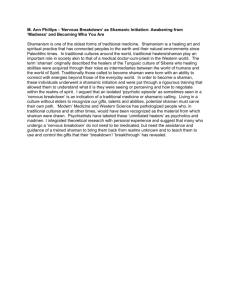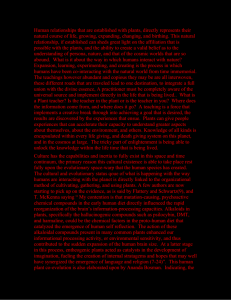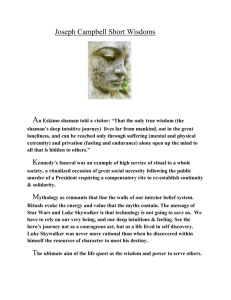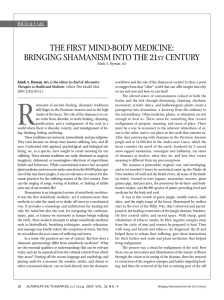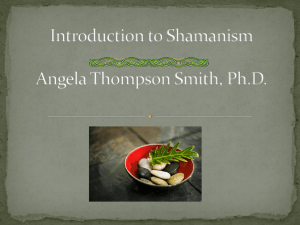Word Count: 1784 An Exploration of Spiritual Healing
advertisement
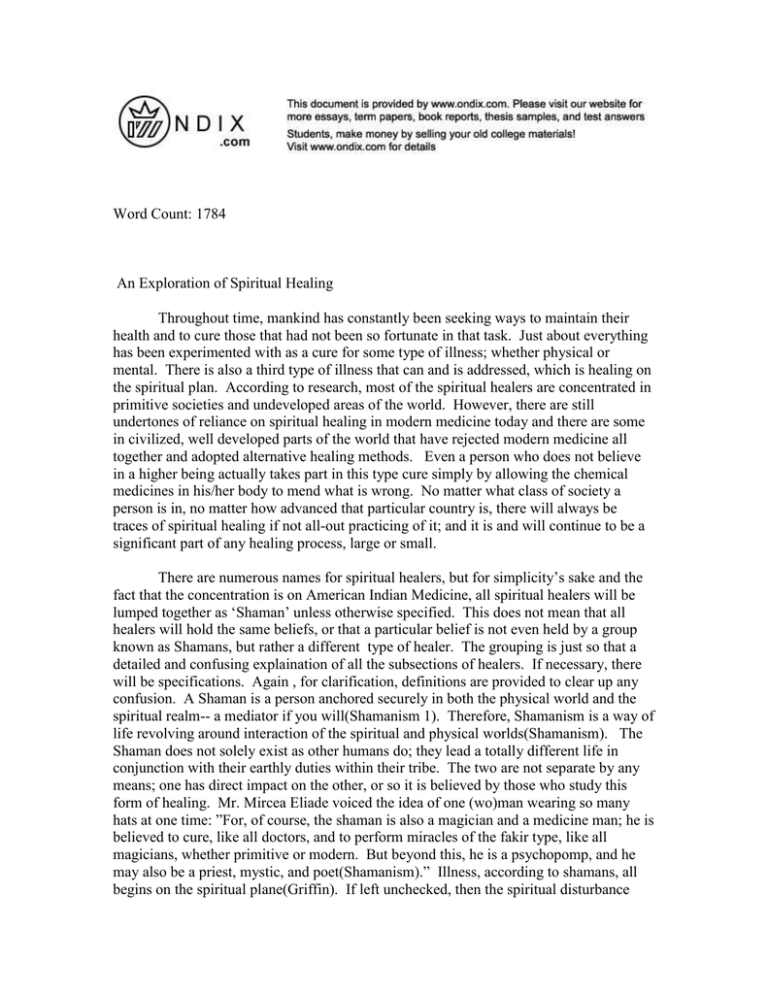
Word Count: 1784 An Exploration of Spiritual Healing Throughout time, mankind has constantly been seeking ways to maintain their health and to cure those that had not been so fortunate in that task. Just about everything has been experimented with as a cure for some type of illness; whether physical or mental. There is also a third type of illness that can and is addressed, which is healing on the spiritual plan. According to research, most of the spiritual healers are concentrated in primitive societies and undeveloped areas of the world. However, there are still undertones of reliance on spiritual healing in modern medicine today and there are some in civilized, well developed parts of the world that have rejected modern medicine all together and adopted alternative healing methods. Even a person who does not believe in a higher being actually takes part in this type cure simply by allowing the chemical medicines in his/her body to mend what is wrong. No matter what class of society a person is in, no matter how advanced that particular country is, there will always be traces of spiritual healing if not all-out practicing of it; and it is and will continue to be a significant part of any healing process, large or small. There are numerous names for spiritual healers, but for simplicity’s sake and the fact that the concentration is on American Indian Medicine, all spiritual healers will be lumped together as ‘Shaman’ unless otherwise specified. This does not mean that all healers will hold the same beliefs, or that a particular belief is not even held by a group known as Shamans, but rather a different type of healer. The grouping is just so that a detailed and confusing explaination of all the subsections of healers. If necessary, there will be specifications. Again , for clarification, definitions are provided to clear up any confusion. A Shaman is a person anchored securely in both the physical world and the spiritual realm-- a mediator if you will(Shamanism 1). Therefore, Shamanism is a way of life revolving around interaction of the spiritual and physical worlds(Shamanism). The Shaman does not solely exist as other humans do; they lead a totally different life in conjunction with their earthly duties within their tribe. The two are not separate by any means; one has direct impact on the other, or so it is believed by those who study this form of healing. Mr. Mircea Eliade voiced the idea of one (wo)man wearing so many hats at one time: ”For, of course, the shaman is also a magician and a medicine man; he is believed to cure, like all doctors, and to perform miracles of the fakir type, like all magicians, whether primitive or modern. But beyond this, he is a psychopomp, and he may also be a priest, mystic, and poet(Shamanism).” Illness, according to shamans, all begins on the spiritual plane(Griffin). If left unchecked, then the spiritual disturbance manifests itself as a physical malady. A large part of the healing process is to remove barriers within the body to allow the impurities to leave the body, and to incourage the body to heal itself. The energy is channeled through the healer from a higher source like a conductor into the patient and in turn the malevolent entity/ disturbance is pulled into the healer to get rid of, as described by a certified healer in witchcraft(Griffin). To remove the disturbance, different shamans have different techniques. However, the purpose is identical and the end result usually come out about the same frequency of success to failures. There are countless documentations of a shaman sucking an evil spirit from the body of the affected person. Depending on the shaman’s particular style, the spirit may be spat out in the form of saliva or a small mass, sometimes with blood on it(Vogel 16). Along those same lines, bitter medicines are administered to the patient in order to make the body an unpleasant living environment for the evil being and so it will leave(16). Other times, the ill-stricken person is not possessed by an evil spirit, but rather, has a disturbance on the spiritual plane. This usually is the result of an emotional imbalance within the body and can be mended fairly easily. Rattles, drums, and singing are thought to help restabilize the imbalance by first disrupting the harmony of the imbalance, removing it, and refilling the empty space with compatible vibrations(16). The energy used to refill the area cleaned of the imbalance acts as a ’spiritual scar tissue’ and mends the fragmented ends together. There are many other forms of spiritual healing designed to help regain the balance of someone who is ill. During an interview with a spiritual healer from the Witchcraft religion, other types of procedures were described: Auric therapy, dealing with the flow of the aura; aromatic therapy that uses different scents to invoke healing; chromatic and hydro-chromatic, which is the use of colors and water colors, respectively as therapy, and medicinal herbalism. There is also a therapy style called raki-healing, which is the actions most think of when they mentally picture a spiritual healer. It is a combination of channeling energy and massage. There was an opportunity to experience this particular type of healing during the interview. In order to do what they do, shaman must not confine themselves to the physical world. Sometimes, mostly, the soul leaves the body to ascend into the sky to visit the heavens or down into the earth to the underworld. This is called a Shamanistic Flight-one when the shaman travels beyond the limitations of the physical body(Global 1). In addition to traveling to other worlds, Shamans also enlist the help of different fetishes. These fetishes are believed in some circles to provide the Shaman with his/ her healing power. The fetishes are representations of the animal spirit medicine men( Magic 267). Combining the two, there is an act called a parashamanistic technique. There are actually four of them; all involve direct intercourse with the supernatural world. However, only one is characterized by the spirit-possession trance. In this trance, the healing spirit takes over the shaman’s body(194). There are innumerable ways to be chosen to be a shaman: near-death experience, a mental calling, have a tendency, etc. Those are just some of the most common. The common thread throughout is that once (s)he has been chosen, they must be trained. There are special taboos that must be learned in order to become a shaman, but not all of these teachings hold constant through the different tribes. For instance, there are several taboos concerning eating; forbidden to eat outside and cannot eat head, heart, intestines, or liver of an animal(Magic 194). Some tribes have their young shaman refrain from sexual relations, although other cultures allow marriages. It is even accepted in other tribes that the shaman be a transvestite, marry a man that has a wife, do wife jobs as well as be a shaman, and have homosexual relations. There is also a secret vocabulary of the shaman that must be learned and special techniques concerning their function within society(194). Once they have been trained in all the ways of the Shaman, then it is then time for the novice shaman to receive the paraphinalia of the trade. There is precious little the shaman actually needs to perform his task. From his parents, he receives a headdress and a belt( Magic 194). From the instructor, the young Shaman receives his first tunraq (this is an Eskimo custom). A tunraq is a protective spirit to watch over the shaman and to help him with his needs. Additional tunraqs can be given by other shaman for some service done for another, or by following the spirit’s on volition(194). This young shaman, though his training, went through several levels of mental suffering and trance in order to arrive at a new normality and reintegration into the society he was isolated from for years(Gelfund 132). this pain authenticates the young shaman’s contact with the spirit world(132). There is so much talk of the shaman going away to learn, going away to heal, that one might forget that the shaman are an integral part of the community. They concentrate mainly on curing the ill and rainmaking rather than getting involved in the government of the tribe. They are, however, looked to for advice for the leadership of the community. This is because one of the role of a shaman is to be a guardian of the well-being of the tribe, ensuring continuing fertility and health(Magic 264). Then again, shaman do not rely totally on the spiritual realm for healing. They learn considerable knowledge in first aid and herbal cures for ‘natural diseases’. This means that they do not lack empirical knowledge (knowledge gathered from trial and error) and experimental technique(264). Shaman use both learned knowledge and spiritual knowledge to cure those that they come in contact with. Even the interaction between three components of a healing -patient, shaman, and public-- made a considerable difference in the healing. This is called the ‘Shamanistic Complex’(Magic 35). The Shaman undergoes specific states of a psychosomatic nature, the sick person who may or may not experience improvement in their condition, and the public, which is experiencing an enthusiasm and intellectual and emotional satisfaction, which provides collective support(35). This support perpetuates shamanistic healings, and starts the cycle all over again. The whole process of healing, whether modern medicine or alternative, comes out as being at least in part spiritual healing. The theme of having healers come and remove beings from an ill body, or smooth out an imbalance is a constantly reoccurring theme in the medicinal practices of every primitive religion and society. Still, there are distinct traces left in modern culture that suggest there is something more than primitive, uncivilized superstition. Works Cited Gelfund, Michael. Witch Doctor. New York: Fredrick A. Praeger, Inc., Publishers, 1964. 132-33. Griffin, Michelle. Personal Interview. 18 November 1997. Magic, Witchcraft, and Curing. Ed. John Middleton. Garden City, New York: The Natural History Press, 1967. Vogel, Virgil J. American Indian Medicine. Oklahoma University: Oklahoma University Press, 1973. “Shamanism: a definition of sorts.” Earth Dance Society. n. pag. Online. Internet. 17 Nov. 1997. “What is Shamanism?.” Global Spirituality. 1.1 Online. Internet. 17 Nov. 1997 Keywords: word count exploration spiritual healing throughout time mankind constantly been seeking ways maintain their health cure those that been fortunate that task just about everything been experimented with cure some type illness whether physical mental there also third type illness that addressed which healing spiritual plan according research most spiritual healers concentrated primitive societies undeveloped areas world however there still undertones reliance healing modern medicine today there some civilized well developed parts world have rejected modern medicine together adopted alternative methods even person does believe higher being actually takes part this type cure simply allowing chemical medicines body mend what wrong matter what class society person matter advanced particular country will always traces practicing will continue significant part process large small numerous names healers simplicity sake fact concentration american indian medicine healers will lumped together shaman unless otherwise specified this does mean hold same beliefs particular belief even held group known shamans rather different healer grouping just detailed confusing explaination subsections necessary specifications again clarification definitions provided clear confusion shaman person anchored securely both physical world realm mediator shamanism therefore shamanism life revolving around interaction physical worlds shamanism shaman does solely exist other humans they lead totally different life conjunction with their earthly duties within their tribe separate means direct impact other believed those study this form mircea eliade voiced idea wearing many hats time course also magician believed like doctors perform miracles fakir like magicians whether primitive modern beyond psychopomp also priest mystic poet illness according shamans begins plane griffin left unchecked then disturbance manifests itself malady large part process remove barriers within body allow impurities leave body incourage heal itself energy channeled through healer from higher source like conductor into patient turn malevolent entity disturbance pulled into healer described certified witchcraft griffin remove disturbance different shamans have techniques however purpose identical result usually come about same frequency success failures countless documentations sucking evil spirit from affected depending particular style spirit spat form saliva small mass sometimes with blood vogel along those same lines bitter medicines administered patient order make unpleasant living environment evil being leave other times stricken possessed evil spirit rather plane usually result emotional imbalance within mended fairly easily rattles drums singing thought help restabilize imbalance first disrupting harmony imbalance removing refilling empty space compatible vibrations energy used refill area cleaned acts scar tissue mends fragmented ends together many forms designed help regain balance someone during interview from witchcraft religion types procedures were described auric therapy dealing flow aura aromatic therapy uses scents invoke chromatic hydro chromatic which colors water colors respectively therapy medicinal herbalism style called raki which actions most think when they mentally picture combination channeling energy massage opportunity experience during interview order what they must confine themselves sometimes mostly soul leaves ascend into visit heavens down earth underworld called shamanistic flight when travels beyond limitations global addition traveling worlds enlist help fetishes these fetishes believed some circles provide power fetishes representations animal magic combining called parashamanistic technique actually four them involve direct intercourse supernatural however only characterized possession trance trance takes over innumerable ways chosen near death experience mental calling have tendency just most common common thread throughout once chosen must trained special taboos must learned order become these teachings hold constant through tribes instance several taboos concerning eating forbidden outside cannot head heart intestines liver animal magic tribes young refrain sexual relations although cultures allow marriages even accepted tribes transvestite marry wife wife jobs well homosexual relations secret vocabulary learned special techniques concerning function society once trained ways then then time novice receive paraphinalia trade precious little actually needs perform task parents receives headdress belt magic instructor young receives first tunraq eskimo custom tunraq protective watch over needs additional tunraqs given service done another following volition young though training went through several levels mental suffering trance arrive normality reintegration society isolated years gelfund pain authenticates contact much talk going away learn going away heal might forget integral community concentrate mainly curing rainmaking rather than getting involved government tribe looked advice leadership community because role guardian well being tribe ensuring continuing fertility health again rely totally realm learn considerable knowledge first herbal cures natural diseases means lack empirical knowledge knowledge gathered trial error experimental technique both learned come contact interaction between three components patient public made considerable difference shamanistic complex undergoes specific states psychosomatic nature sick experience improvement condition public experiencing enthusiasm intellectual emotional satisfaction provides collective support support perpetuates shamanistic healings starts cycle over again whole process whether alternative comes least theme having come remove beings smooth constantly reoccurring theme medicinal practices every primitive religion still distinct traces left culture suggest something more than uncivilized superstition works cited gelfund michael witch doctor york fredrick praeger publishers griffin michelle personal interview november witchcraft curing john middleton garden city york natural history press vogel virgil american indian oklahoma university oklahoma university press definition sorts earth dance online internet global spirituality online internet Keywords General: Essay, essays, termpaper, term paper, termpapers, term papers, book reports, study, college, thesis, dessertation, test answers, free research, book research, study help, download essay, download term papers
